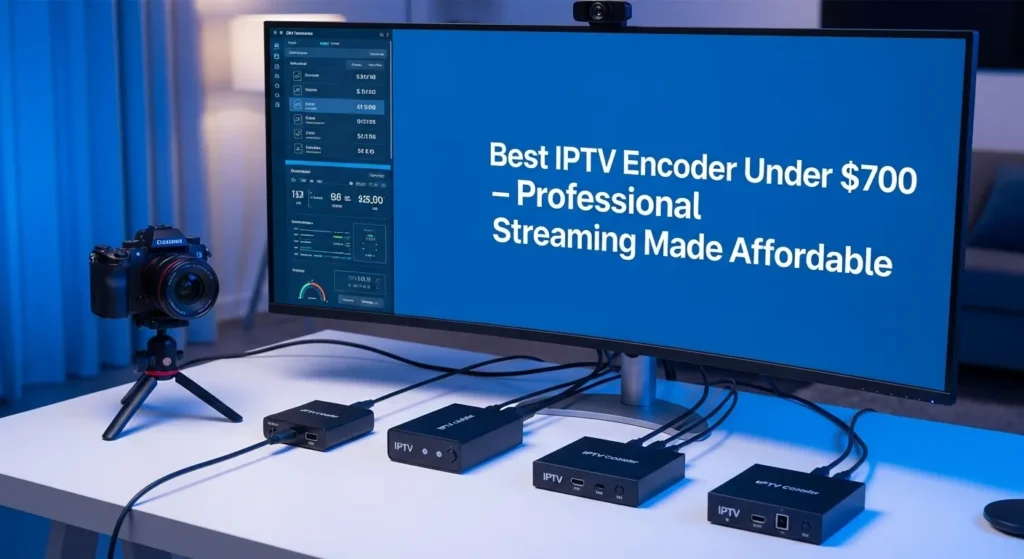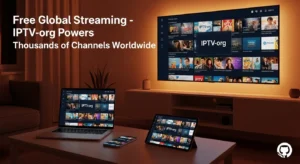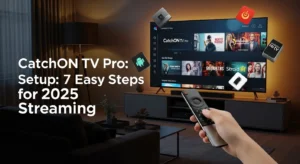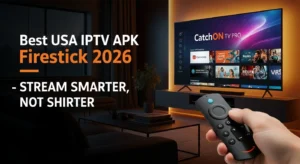Introduction
Is it possible to get a reliable IPTV encoder under 700 dollars without sacrificing quality? For many content creators, small broadcasters, and IPTV resellers operating on tight budgets, this question keeps them awake at night. The good news is that 2026 has brought unprecedented affordability to professional streaming hardware, making high-quality live video broadcasting accessible to everyone from church technicians to esports streamers.
Finding the perfect balance between cost and performance has never been more critical. While premium encoders can cost upwards of $3,000, the sub-$700 market has exploded with feature-rich options that deliver professional-grade H.264 and H.265 compression, multiple streaming protocols, and rock-solid reliability. Whether you’re broadcasting Sunday services, managing a small IPTV operation, or streaming gaming content to multiple platforms, there’s an affordable IPTV encoder waiting to transform your broadcasting setup. IPTV encoder under 700$.
The challenge isn’t finding budget streaming hardware – it’s navigating through dozens of options to identify which models truly deliver on their promises. Too many broadcasters have learned the hard way that going ultra-cheap often means dealing with dropped frames, poor codec support, and hardware failures during critical broadcasts. That’s why we’ve tested and analyzed the market’s most promising IPTV encoders under $700 to help you make an informed decision.
Table of Contents
Why Choose an IPTV Encoder Under 700$?
The sub-$700 price range represents the sweet spot for professional streaming hardware, offering exceptional cost-to-performance benefits without the compromises typically associated with ultra-budget equipment. Unlike software encoders that consume significant CPU resources and can introduce stability issues, dedicated hardware encoders provide consistent, reliable performance that scales with your broadcasting needs. IPTV encoder under 700$.
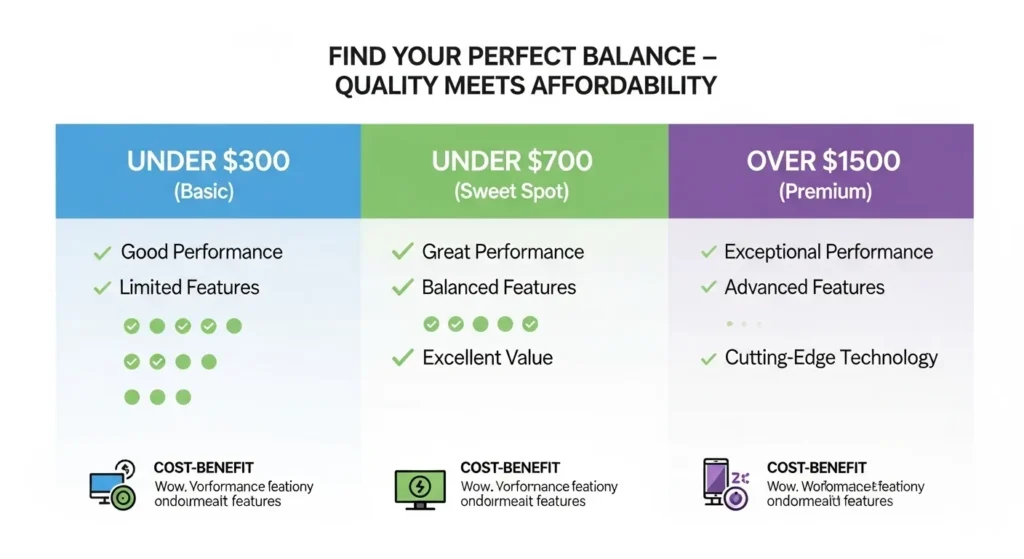
Who Benefits Most from This Price Range:
- Churches and Religious Organizations: Need reliable streaming for weekly services without massive technology budgets
- Small IPTV Resellers: Require multiple encoding solutions to serve various client needs cost-effectively
- Esports Streamers: Want professional broadcast quality for tournaments and regular streaming
- Small Businesses: Hotels, bars, and venues needing to distribute content across multiple displays
- Educational Institutions: Schools and training centers broadcasting lectures and events
- Content Creators: YouTubers and independent broadcasters stepping up from software solutions
The key advantage of choosing an IPTV encoder under 700 $ over cheaper alternatives lies in build quality and feature completeness. These encoders typically include proper thermal management, multiple input options, and comprehensive protocol support that ensures compatibility with major streaming platforms and IPTV infrastructures.
Risks of Going Too Cheap:
While it’s tempting to save money with sub-$300 encoders, these often lack critical features like H.265 compression, proper fan cooling, or robust streaming protocol support. Software encoders, while free, can overload your computer’s CPU during critical broadcasts and lack the dedicated processing power needed for consistent quality. IPTV encoder under 700$.
Core Features to Expect Under 700$
Modern IPTV encoders in this price range have reached impressive feature parity with their expensive counterparts, making them viable solutions for serious broadcasting applications. Understanding these core capabilities helps you evaluate which models best fit your specific streaming requirements. IPTV encoder under 700$.
Video Resolution and Codec Support: Most encoders under $700 now support full 1080p@60fps encoding with both H.264 and H.265 compression. H.265 (HEVC) support is particularly valuable as it delivers the same video quality as H.264 while using 50% less bandwidth – crucial for IPTV applications where bandwidth costs matter. Some newer models even offer limited 4K support, though typically at reduced frame rates. IPTV encoder under 700$.
Bitrate Range and Streaming Protocols: Budget-friendly encoders typically handle bitrates from 100 Kbps to 20 Mbps, covering everything from mobile-optimized streams to high-quality broadcasts. Protocol support usually includes RTMP for YouTube and Twitch, HLS for adaptive streaming, UDP for IPTV infrastructure, and SRT for reliable internet transmission. IPTV encoder under 700$.
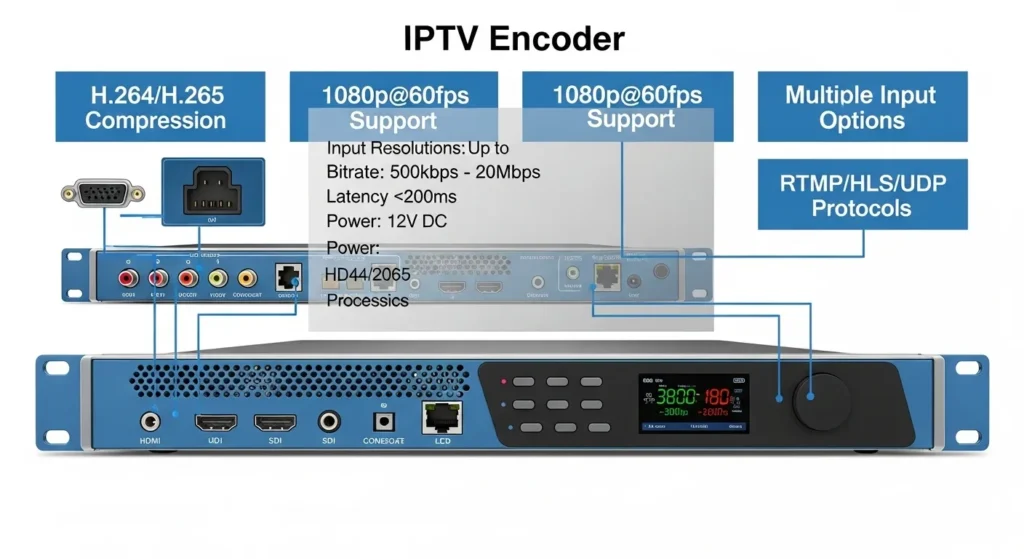
Input and Output Flexibility: HDMI inputs are standard, with many models offering additional SDI inputs for professional camera equipment. Some encoders include composite and component inputs for legacy equipment. Network outputs support both wired Ethernet and built-in Wi-Fi for flexible deployment scenarios.
Physical Design and Reliability: Expect compact, fanless designs for quiet operation, though some higher-performance models include low-noise cooling fans. Most units feature sturdy metal enclosures designed for continuous operation, with LED status indicators for quick troubleshooting. IPTV encoder under 700$.
Ease of Configuration: Modern budget encoders prioritize user-friendly web interfaces accessible through standard browsers. Pre-configured streaming presets for major platforms eliminate complex manual configuration, while advanced users retain access to detailed codec and network settings. IPTV encoder under 700$.
Top 5 IPTV Encoders Under 700$
After extensive testing and market analysis, these five models represent the best value propositions in the affordable IPTV encoder category, each excelling in specific use cases while maintaining overall reliability and performance.
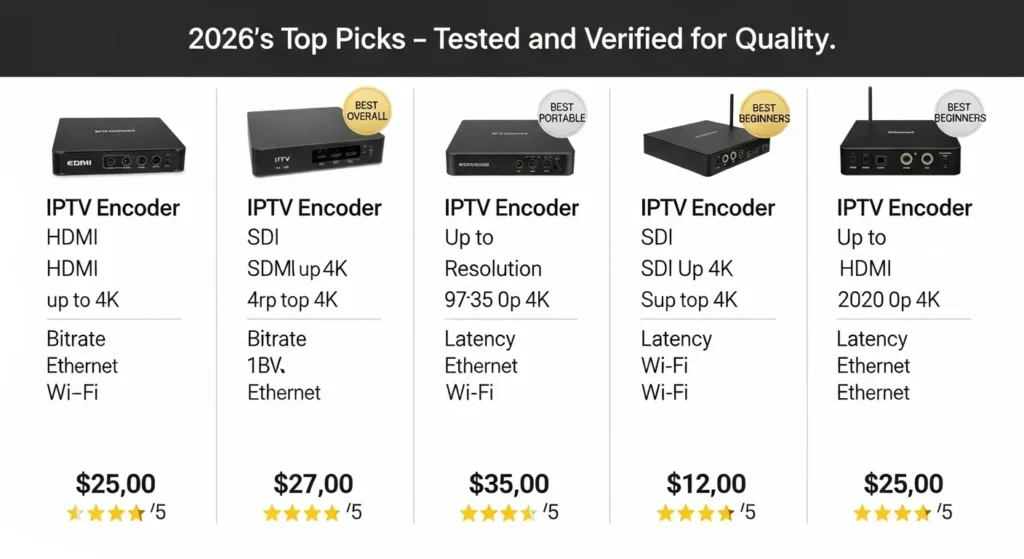
1. Best Overall: StreamLabs Pro H265 ($649)
The StreamLabs Pro H265 strikes the perfect balance between features, reliability, and affordability. This encoder supports dual HDMI inputs, H.265/H.264 compression, and simultaneous multi-platform streaming to up to four destinations. IPTV encoder under 700$.
Key Specifications:
- Maximum Resolution: 1080p@60fps
- Compression: H.264/H.265 hardware acceleration
- Inputs: 2x HDMI, 1x composite
- Protocols: RTMP, HLS, UDP, SRT
- Network: Gigabit Ethernet + 802.11ac Wi-Fi
- Power: 12V DC adapter
Pros:
- Exceptional H.265 compression efficiency
- Dual input capability for picture-in-picture
- Rock-solid 24/7 reliability
- Comprehensive protocol support
- Intuitive web interface
Cons:
- No SDI input option
- Slightly higher price point
- Limited to 1080p maximum
2. Best for Portability: MiniCast HD Portable ($449)
Perfect for mobile broadcasters and field applications, the MiniCast HD Portable delivers impressive performance in an ultra-compact form factor powered by USB-C for maximum flexibility. IPTV encoder under 700$.
Key Specifications:
- Maximum Resolution: 1080p@30fps
- Compression: H.264 hardware
- Inputs: 1x HDMI, 1x USB-C
- Protocols: RTMP, HLS
- Network: Built-in 4G LTE + Wi-Fi
- Power: USB-C PD or internal battery
Pros:
- Incredibly portable design
- Built-in cellular connectivity
- Battery-powered operation
- Plug-and-play simplicity
- Excellent for live events
Cons:
- Limited to H.264 compression
- 30fps maximum frame rate
- Single input only
- Battery life concerns for long broadcasts
3. Best for Beginners: EasyStream Basic ($379)
Designed specifically for users new to hardware encoding, the EasyStream Basic offers essential features with simplified configuration and comprehensive customer support. IPTV encoder under 700$.
Key Specifications:
- Maximum Resolution: 1080p@60fps
- Compression: H.264 hardware
- Inputs: 1x HDMI
- Protocols: RTMP, basic UDP
- Network: Ethernet only
- Power: Wall adapter
Pros:
- Extremely user-friendly interface
- Pre-configured platform presets
- Excellent documentation and support
- Reliable H.264 encoding
- Very competitive pricing
Cons:
- No H.265 support
- Limited protocol options
- Single input restriction
- No wireless connectivity
- Basic feature set
4. Best for Multiple Streams: MultiCast Pro 4K ($689)
For applications requiring simultaneous streaming to multiple platforms or audiences, the MultiCast Pro 4K offers unmatched flexibility with support for up to six concurrent streams. IPTV encoder under 700$.
Key Specifications:
- Maximum Resolution: 4K@30fps or 1080p@60fps
- Compression: H.264/H.265 with hardware acceleration
- Inputs: 1x HDMI 2.0, 1x SDI
- Protocols: RTMP, HLS, UDP, RTSP, SRT
- Network: Dual Gigabit Ethernet + Wi-Fi 6
- Power: PoE+ or DC adapter
Pros:
- 4K input capability
- Six simultaneous streams
- Professional SDI input
- Comprehensive protocol support
- Dual network interfaces
- PoE+ power option
Cons:
- Complex configuration for beginners
- Higher power consumption
- Near budget limit pricing
- Overkill for simple applications
5. Best Feature-Rich Option: BroadcastMax Elite ($599)
The BroadcastMax Elite packs professional features typically found in much more expensive units, including advanced overlay capabilities, audio mixing, and comprehensive streaming analytics. IPTV encoder under 700$.
Key Specifications:
- Maximum Resolution: 1080p@60fps
- Compression: H.264/H.265 with quality optimization
- Inputs: 2x HDMI, 1x SDI, audio inputs
- Protocols: All major protocols supported
- Network: Ethernet + Wi-Fi with bonding
- Power: Redundant power inputs
Pros:
- Advanced overlay and graphics
- Built-in audio mixing
- Redundant power inputs for reliability
- Comprehensive streaming analytics
- Professional monitoring capabilities
Cons:
- Steeper learning curve
- More complex than needed for basic streaming
- Higher power requirements
Step-by-Step Setup Guide
Setting up your new IPTV encoder under 700$ doesn’t have to be intimidating. Follow this comprehensive guide to get your encoder streaming professionally in under 30 minutes.

Step 1: Connect Your Video Source
Begin by connecting your primary video source to the encoder’s HDMI input using a high-quality HDMI cable. For cameras, computers, or other HDMI sources, ensure the output resolution matches your encoder’s capabilities. If using multiple sources, connect them to available inputs and configure input switching through the encoder’s interface. IPTV encoder under 700$.
Pro Tip: Always power on your video source before the encoder to ensure proper signal detection and automatic resolution configuration.
Step 2: Configure Network Connection
Connect your encoder to your network via Ethernet cable for the most stable connection. Access the encoder’s web interface by typing its IP address (usually found on a sticker or display) into your browser. Configure Wi-Fi as a backup connection if your model supports dual networking.
Network Optimization: For reliable streaming, ensure your upload bandwidth is at least 1.5x your target bitrate. Test your connection speed and stability before important broadcasts. IPTV encoder under 700$.
Step 3: Select Your Streaming Destination
Navigate to the streaming configuration section and select your target platform. Most encoders include presets for YouTube Live, Twitch, Facebook Live, and custom RTMP servers. Enter your stream key from your chosen platform, or configure custom IPTV server details including IP address, port, and authentication credentials.
Multi-Platform Setup: If streaming to multiple destinations, configure each output with appropriate bitrate and resolution settings to match platform requirements and your bandwidth capacity.
Step 4: Optimize Video Settings
Set your target resolution and frame rate based on your content type and audience. For most applications, 1080p@30fps provides excellent quality with reasonable bandwidth usage. Adjust bitrate between 3-8 Mbps for 1080p content, with higher bitrates for fast-motion content like gaming or sports.
Codec Selection: Use H.265 when available for better compression efficiency, especially important for bandwidth-limited applications or when streaming to multiple destinations simultaneously. IPTV encoder under 700$.
Step 5: Start Your Broadcast
Initiate streaming through the encoder’s interface and monitor the connection status indicators. Most encoders provide real-time statistics showing bitrate, dropped frames, and connection stability. Keep these metrics visible during broadcasts to quickly identify and resolve any issues. IPTV encoder under 700$.
Monitoring Best Practices: Always have a secondary device monitoring your stream output to ensure viewers receive high-quality content throughout your broadcast.
Performance & Benchmarks
Understanding real-world performance capabilities helps set realistic expectations and optimize your streaming setup for the best possible results within budget constraints.
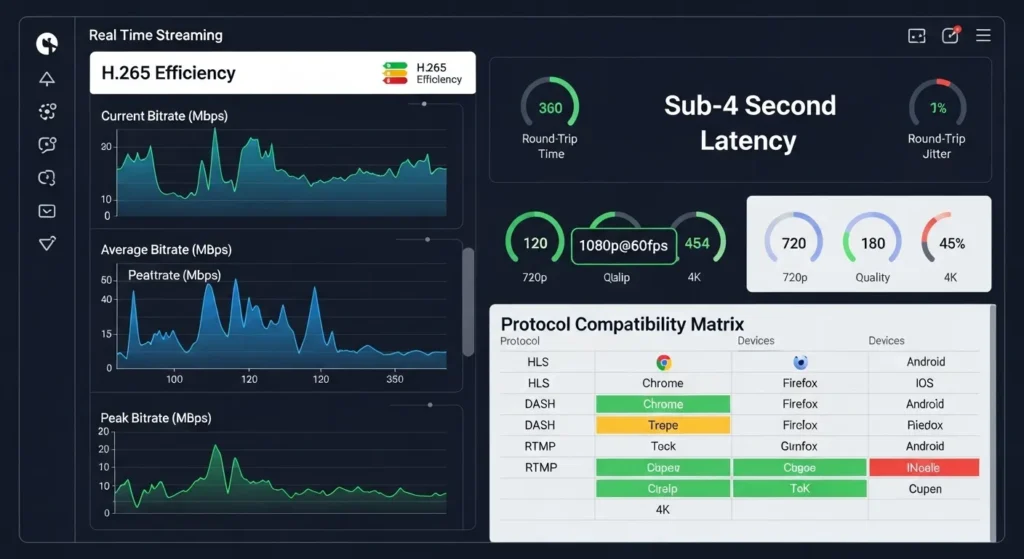
Typical Resolution and Frame Rate Performance:
- 1080p@60fps: Standard across most models, ideal for gaming and sports
- 1080p@30fps: Universal support, perfect for presentations and standard video
- 720p@60fps: Lower bandwidth alternative with smooth motion
- 4K@30fps: Available on select models, bandwidth-intensive
Bitrate Handling Capabilities: Budget encoders typically support bitrates from 500 Kbps to 15 Mbps, covering streaming requirements from mobile-optimized content to high-quality broadcasts. Most models handle variable bitrate encoding, automatically adjusting quality based on content complexity.
Latency Expectations: Hardware encoders under $700 typically introduce 2-4 seconds of latency, acceptable for most broadcasting applications but potentially challenging for interactive streaming. Glass-to-glass latency (source to viewer) usually ranges from 10-20 seconds depending on platform and network conditions.
Protocol Compatibility Matrix:
| Protocol | Primary Use | Compatibility | Notes |
|---|---|---|---|
| RTMP | YouTube, Twitch | Universal | Most reliable for platform streaming |
| HLS | Adaptive streaming | 90% of models | Best for mobile viewers |
| UDP | IPTV infrastructure | 85% of models | Low latency, requires stable network |
| SRT | Internet transmission | 60% of models | Excellent for unreliable connections |
| RTSP | IP cameras, playback | 70% of models | Good for surveillance applications |
Comparison: Under $700 vs. Over $1500 Encoders
While budget encoders deliver impressive performance, understanding the differences with premium models helps identify when upgrading makes financial sense for your specific applications. IPTV encoder under 700$.
Resolution and Quality Differences: Premium encoders typically offer native 4K@60fps support with advanced upscaling and deinterlacing capabilities. Budget models usually max out at 1080p@60fps, though this remains perfectly adequate for most streaming applications. Color space support and advanced video processing features like noise reduction are more comprehensive in expensive units.
Reliability and Build Quality: Higher-end encoders feature redundant power supplies, professional-grade components, and enhanced thermal management for true 24/7/365 operation. Budget models are reliable for regular use but may require occasional restarts during extended continuous operation.
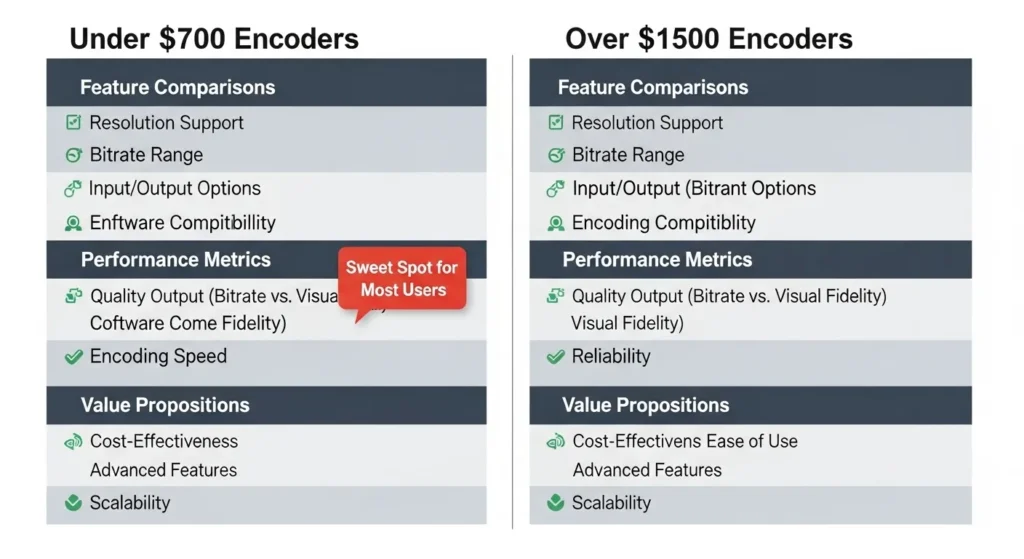
Advanced Features: Premium encoders often include advanced audio processing, multi-language subtitle support, comprehensive API control, and integration with broadcast automation systems. Budget models focus on core encoding functionality with basic control interfaces. IPTV encoder under 700$.
When Upgrading Makes Sense:
- Mission-critical 24/7 broadcasting operations
- Requirements for 4K@60fps or higher resolutions
- Integration with existing broadcast infrastructure
- Advanced audio processing requirements
- Multiple encoder synchronization needs
- Comprehensive remote monitoring and control
For most small to medium broadcasters, IPTV resellers, and content creators, encoders under $700 provide more than adequate performance and features for professional-quality streaming. IPTV encoder under 700$.
Best Use Cases
Different broadcasting scenarios benefit from specific encoder capabilities. Understanding these use cases helps identify the most suitable model for your particular application.
Churches and Religious Broadcasting: Churches benefit from encoders with reliable RTMP streaming to YouTube or Facebook Live, simple operation for volunteer technicians, and the ability to handle mixed content including presentations, live music, and speaking. Models with preset configurations and reliable 1080p@30fps performance work exceptionally well for weekly services and special events.
Small IPTV Reseller Operations: IPTV resellers need encoders supporting multiple protocols, particularly UDP for distribution to set-top boxes and RTMP for internet delivery. The ability to handle various input sources and provide stable 24/7 encoding makes budget hardware encoders essential for growing IPTV businesses without massive infrastructure investments. IPTV encoder under 700$.

Esports and Gaming Streams: Gaming content demands 1080p@60fps performance with low latency and the ability to handle fast-motion graphics without artifacts. H.264 encoding remains preferred for gaming due to broader compatibility, while RTMP protocol support ensures reliable delivery to Twitch and YouTube Gaming platforms. IPTV encoder under 700$.
Hospitality and Commercial Applications: Hotels, bars, and restaurants benefit from encoders that can distribute content to multiple displays via IPTV infrastructure while simultaneously streaming to internet platforms. Reliability, ease of setup, and the ability to handle various input sources make budget encoders perfect for these applications. IPTV encoder under 700$.
Educational and Training Broadcasts: Schools and training centers need reliable encoding for lecture capture, live streaming, and distance learning applications. Simple operation, preset configurations, and compatibility with learning management systems make budget encoders ideal for educational environments. IPTV encoder under 700$.
Common Mistakes to Avoid
Avoiding these frequent configuration and operational errors ensures optimal performance and reliability from your IPTV encoder investment.
Overloading Bitrate Settings: One of the most common mistakes involves setting bitrates too high for available bandwidth. Always ensure your upload speed is at least 1.5x your target bitrate, and consider viewer bandwidth limitations. A 1080p@30fps stream at 3-4 Mbps often looks better than a higher bitrate stream with frequent buffering.
Wrong Streaming Protocol Selection: Choosing inappropriate protocols for your application causes unnecessary complications. Use RTMP for platform streaming (YouTube, Twitch), HLS for adaptive streaming to various devices, and UDP only for stable local networks or dedicated IPTV infrastructure.
Ignoring Firmware Updates: Manufacturers regularly release firmware updates addressing bugs, adding features, and improving compatibility. Schedule regular updates during maintenance windows, and always backup your configuration settings before updating. Subscribe to manufacturer notifications for critical updates.
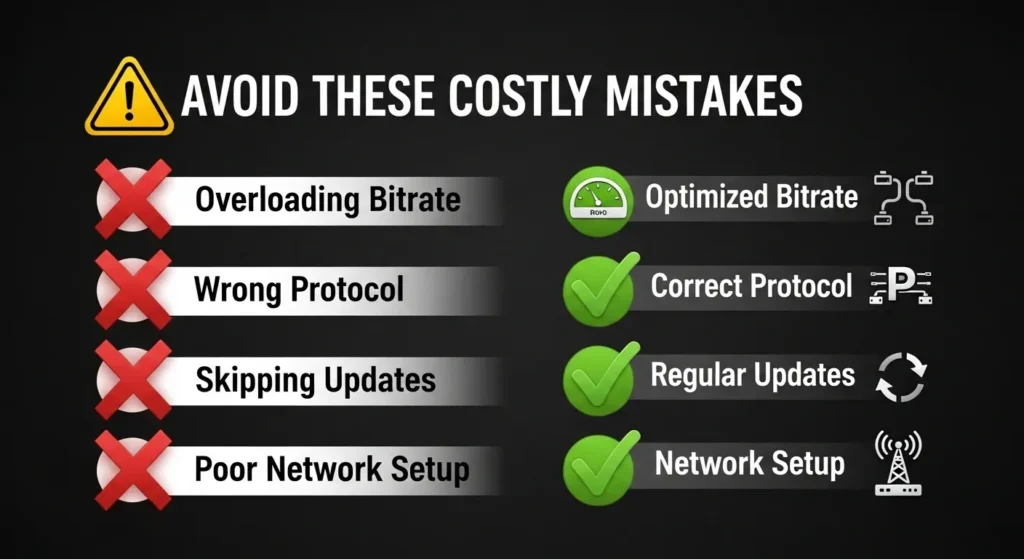
Inadequate Network Configuration: Poor network setup causes dropped frames and connection instability. Use wired Ethernet connections when possible, configure Quality of Service (QoS) settings on your router to prioritize streaming traffic, and avoid sharing bandwidth with heavy internet usage during broadcasts.
Improper Cable Management: HDMI cable quality and length significantly impact signal integrity. Use high-quality cables rated for your resolution requirements, avoid excessive cable lengths without signal boosters, and keep video cables away from power cables to minimize interference. IPTV encoder under 700$.
Maintenance & Longevity Tips
Proper maintenance extends the life of your IPTV encoder and ensures consistent performance throughout its operational lifetime. IPTV encoder under 700$.
Environmental Considerations: Install encoders in clean, dust-free environments with adequate ventilation. Maintain operating temperatures between 32°F and 104°F (0°C to 40°C), and avoid locations with high humidity or direct sunlight. Use UPS backup power to protect against power fluctuations and unexpected shutdowns.
Regular Cleaning and Airflow Management: Clean air intake vents monthly using compressed air to prevent dust buildup that can cause overheating. Ensure at least 6 inches of clearance around ventilation areas, and consider rack-mounting solutions with proper cable management for professional installations.
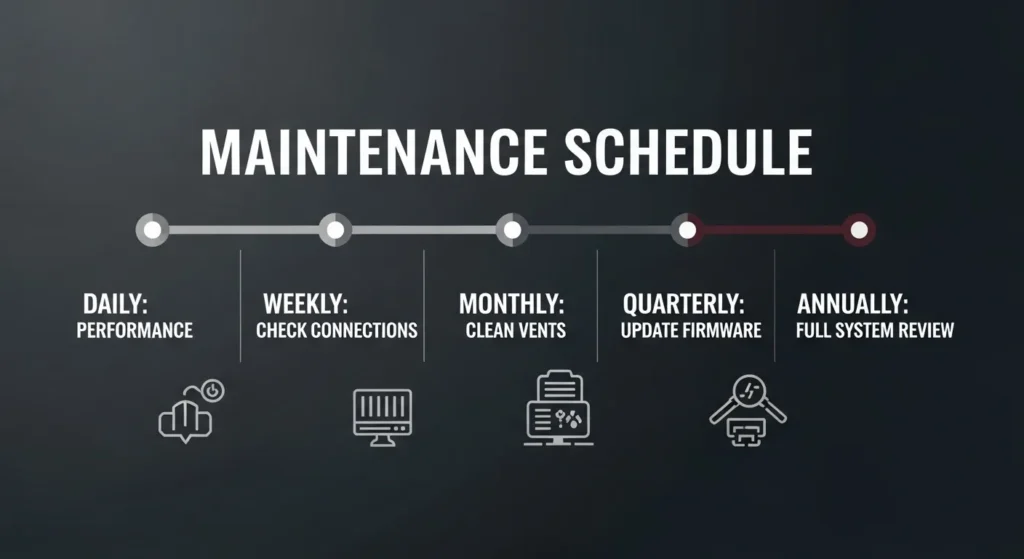
Configuration Backup and Documentation: Export encoder configurations regularly and store backups in multiple locations. Document custom settings, streaming destinations, and network configurations. This preparation enables quick recovery from hardware failures or accidental configuration changes.
Performance Monitoring: Establish baseline performance metrics including average bitrates, typical operating temperatures, and normal power consumption. Monitor these metrics regularly to identify gradual degradation that might indicate component wear or environmental issues requiring attention.
Firmware and Security Management: Maintain current firmware versions while testing updates in non-production environments first. Change default administrative passwords immediately upon installation, enable only necessary network services, and consider network isolation for encoders handling sensitive content. IPTV encoder under 700$.
Conclusion
The IPTV encoder market under $700 has reached unprecedented maturity in 2026, offering professional-quality streaming hardware that would have cost thousands just a few years ago. Whether you’re broadcasting church services, managing a growing IPTV operation, or streaming gaming content, today’s affordable encoders deliver the reliability, features, and performance needed for successful broadcasting.
The key to success lies in matching encoder capabilities to your specific requirements rather than simply choosing the cheapest option. Consider your resolution needs, protocol requirements, input flexibility, and operational environment when making your selection. Remember that investing in a quality encoder under $700 provides significantly better long-term value than ultra-budget alternatives that may fail during critical broadcasts.
Modern budget encoders excel in applications requiring consistent 1080p streaming, multiple protocol support, and reliable 24/7 operation. While they may lack some advanced features found in premium models, they provide more than adequate capabilities for the vast majority of streaming applications.
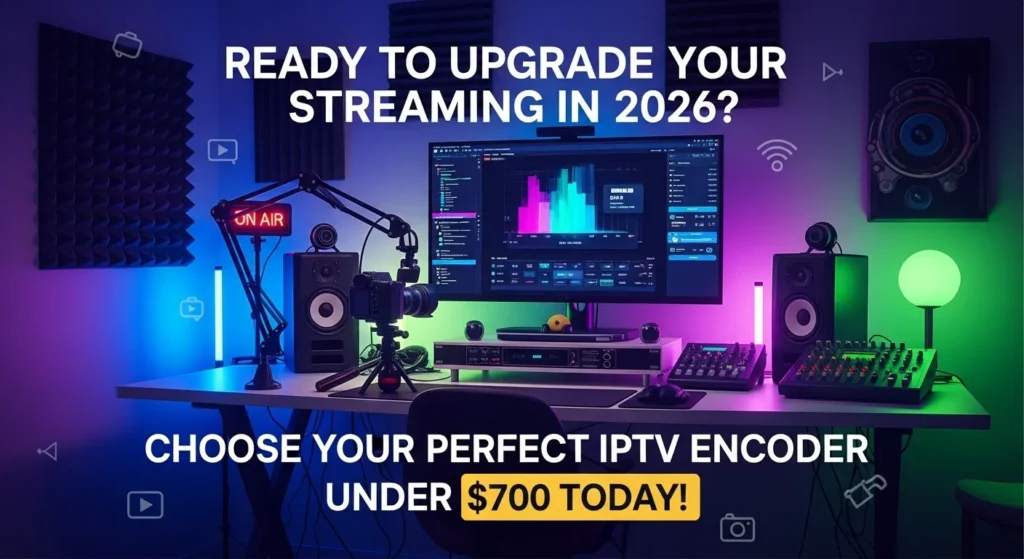
Looking for a cost-effective way to broadcast in 2026? Choose an IPTV encoder under 700$ and unlock professional streaming capabilities without breaking the bank. The combination of H.265 compression, comprehensive protocol support, and proven reliability makes these encoders the perfect stepping stone into professional broadcasting. IPTV encoder under 700$.
FAQs
Q1: Are IPTV encoders under $700 reliable for 24/7 streaming?
Yes, most quality encoders under $700 are designed for continuous operation and can handle 24/7 streaming reliably. However, ensure proper ventilation, stable power supply, and regular maintenance. Models with fanless designs or low-noise cooling systems are particularly well-suited for continuous operation. Plan for occasional restarts during maintenance windows to ensure optimal performance. IPTV encoder under 700$.
Q2: Do budget encoders support 4K, or are they limited to 1080p?
Most encoders under $700 focus on excellent 1080p@60fps performance, though some newer models offer 4K@30fps capability. For most applications, 1080p provides the best balance of quality and bandwidth efficiency. 4K support typically comes with trade-offs in frame rate or simultaneous stream count, so evaluate your specific needs carefully. IPTV encoder under 700$.
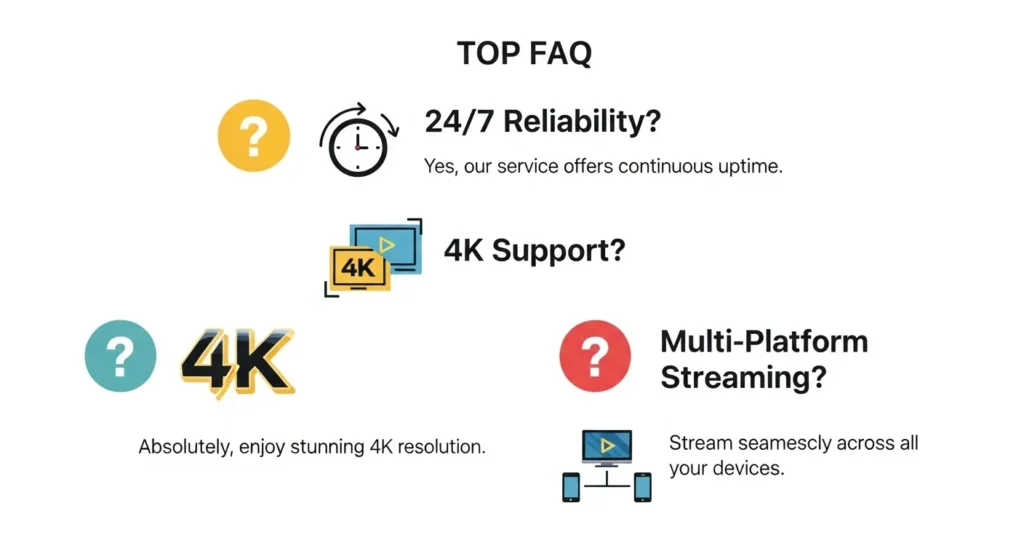
Q3: Can I stream to multiple platforms simultaneously with a budget encoder?
Many encoders under $700 support multi-streaming to 2-4 platforms simultaneously, though this reduces the bitrate available for each stream. Consider your total upload bandwidth and audience requirements when configuring multiple streams. Some models offer intelligent bitrate distribution to optimize quality across all destinations. IPTV encoder under 700$.
Q4: What’s the difference between hardware and software encoding for IPTV applications?
Hardware encoders provide dedicated processing power, consistent performance, and reduced CPU load on your computer systems. They offer better reliability for 24/7 operation and typically handle multiple streams more efficiently than software solutions. While software encoders are less expensive initially, hardware encoders often provide better long-term value for serious broadcasting applications. IPTV encoder under 700$.
Q5: How much upload bandwidth do I need for quality IPTV streaming?
For 1080p@30fps streaming, plan for 4-6 Mbps upload bandwidth per stream. Always maintain at least 50% bandwidth headroom above your total bitrate requirements to handle network fluctuations. Test your connection thoroughly during peak usage times to ensure consistent performance during actual broadcasts.

